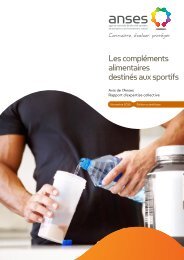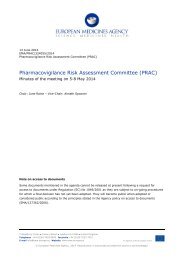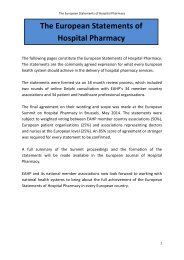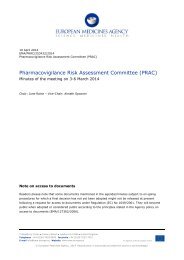WC500185968
WC500185968
WC500185968
Create successful ePaper yourself
Turn your PDF publications into a flip-book with our unique Google optimized e-Paper software.
The exposure for Kepivance, a centrally authorised medicine containing palifermin, is estimated to<br />
have been more than 17,287 patients worldwide, in the period from first authorisation in 2005 up to<br />
January 2012.<br />
A signal of increased mortality associated with the unlicensed use of palifermin in acute lung injury was<br />
identified by EMA, based on the results of the recently completed keratinocyte growth factor in acute<br />
lung injury to reduce pulmonary dysfunction (KARE) study. The MAH provided EMA with a summary of<br />
the results of this investigator-sponsored randomised placebo-controlled study in patients with acute<br />
lung injury conducted in Northern Ireland. The study results showed that intensive care unit (ICU) and<br />
28-day survival were significantly lower in the palifermin group compared to placebo. In addition, the<br />
palifermin group had a longer duration of ventilator use, ICU stay and hospital stay. The Rapporteur<br />
confirmed that the signal needed initial analysis and prioritisation by the PRAC.<br />
Discussion<br />
The PRAC discussed the information provided by the MAH on the KARE study and noted that the<br />
approved indication and the KARE study differ in terms of patient population, conditions treated and<br />
posology. Randomised clinical trials, observational studies and spontaneous reports in patients with<br />
haematological malignancies have not raised a signal of increased mortality or pulmonary events with<br />
palifermin. Pulmonary events, both infectious and non-infectious, are currently included as an<br />
important potential risk in the RMP. The PRAC agreed that no regulatory action was necessary based<br />
on this study report and that the MAH should continue to closely monitor pulmonary adverse events<br />
including fatal cases in future PSURs. The PRAC considered that the investigator should be encouraged<br />
to promptly publish the results in a suitable peer reviewed publication of the KARE study.<br />
Summary of recommendation(s)<br />
<br />
No regulatory action was considered necessary based on this study report; however the MAH<br />
should continue to closely monitor pulmonary adverse events including fatal cases in future<br />
PSURs.<br />
4.2.6. Warfarin (NAP)<br />
<br />
Signal of bone density decrease<br />
Regulatory details:<br />
PRAC Rapporteur: Torbjörn Callreus (DK)<br />
Administrative details:<br />
EPITT 18173 – New signal<br />
MAH(s): various<br />
Lead MS: DK<br />
Background<br />
Warfarin is an oral anticoagulant used for short and long term prevention of thrombo-embolic<br />
disorders, including treatment and prevention of deep venous thrombosis and pulmonary embolism,<br />
secondary prevention of myocardial infarction and prevention of thromboembolic complications (stroke<br />
or systemic embolism) after myocardial infarction, and prevention of thromboembolic complications in<br />
patients with atrial fibrillation, cardiac valvular disease and or prosthetic heart valves.<br />
The worldwide exposure for medicines containing warfarin is estimated to have been very large, since<br />
the medicine has been extensively prescribed since its first authorisation in the mid-1950s.<br />
Pharmacovigilance Risk Assessment Committee (PRAC)<br />
EMA/PRAC/257790/2015 Page 20/89








